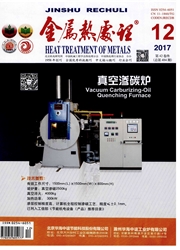

 中文摘要:
中文摘要:
将Mn-Ti型低碳低合金高强钢连铸坯热送至2250热连轧生产线上,设定终轧温度为860℃,终轧至8 mm,然后分别控冷至320、280、240、170和100℃卷取,观察并研究了试验钢的微观组织对冲击性能的影响,分析了不同卷取温度下多种形态铁素体、位错、M-A岛对钢材冲击性能的控制机制。结果表明,随着试验钢卷取温度由320℃降到100℃,试验钢微观组织中位错结构和细小M-A岛的多边形铁素体最有利于冲击吸收能量的增加;当板条状铁素体和大尺寸M-A岛出现时,冲击吸收能量下降;特别是当卷取温度为240℃时,有较大长度的板条状铁素体形成,试验钢的冲击吸收能量下降至最小。
 英文摘要:
英文摘要:
Mn-Ti HSLA steel continuously cast billet was rolled to 8 mm at finishing rolling temperature of 860 ℃ and then respectively cooled to 320,280,240,170 and 100 ℃ in 2250 production line. The effect of microstructure on impact toughness of steel was investigated,and the control mechanisms of different forms of ferrite,dislocation and M-A on impact toughness in different coiling temperature were analyzed. The results show that the microstructure of dislocation structure and the small M-A island ferrite is beneficial to increase of impact absorbed energy when coiled at 320-100 ℃; The impact absorbed energy declines when plate strip ferrite and large M-A island appear when coiled at 240 ℃,and it fall to minimum when the long plate strip ferrite forms.
 同期刊论文项目
同期刊论文项目
 同项目期刊论文
同项目期刊论文
 期刊信息
期刊信息
